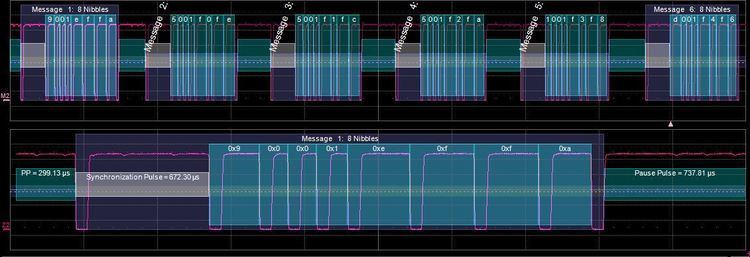 | ||
The SAE J2716 SENT (Single Edge Nibble Transmission) protocol is a point-to-point scheme for transmitting signal values from a sensor to a controller. It is intended to allow for high resolution data transmission with a lower system cost than available serial data solution.
Contents
Hardware
The SENT protocol is a one-way, asynchronous voltage interface which requires three wires: a signal line (low state < 0.5V, high state > 4.1V), a supply voltage line (5V) and a ground line.
Software
Data is transmitted in units of 4 bits (1 nibble) for which the interval between two falling edges (single edge) of the modulated signal with a constant amplitude voltage is evaluated. A SENT message is 32 bits long (8 nibbles) and consists of the following components: 24 bits of signal data (6 nibbles) that represents 2 measurement channels of 3 nibbles each (such as pressure and temperature), 4 bits (1 nibble) for CRC error detection, and 4 bits (1 nibble) of status/communication information. Optionally, data can be transferred in 20 bit messages (5 nibbles) composed of a single 12 bit (3 nibble) measurement, a 4 bit (1 nibble) CRC error checksum, and a 4 bit (1 nibble) status/communication field.
The image below shows the SENT signal described above. In this case a Pause Pulse is used. The Pause Pulse compensates for the varying length of the messages.
